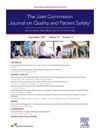Mixed Methods Study of the Interfacility Transfer System Utilizing Both Patient-Reported Experiences and Direct Observation of the Transfer Consent Process
IF 2.4
Q2 HEALTH CARE SCIENCES & SERVICES
Joint Commission journal on quality and patient safety
Pub Date : 2025-01-14
DOI:10.1016/j.jcjq.2025.01.005
引用次数: 0
Abstract
Background
Interfacility transfer is an integral component of the modern health care system. However, there are no commonly agreed-upon standards for interfacility processes or for patient engagement and shared decision-making in transfer, and little is known about their experience. This study used qualitative methods to better understand the patient and care partner experience with interfacility emergency department (ED)-to-ED transfer.
Methods
This mixed methods study used two distinct data sources: (1) semistructured interviews of older adult patients and their care partners, performed at bedside in a large, tertiary care hospital (receiving facility) following interfacility transfer, and (2) direct observation of the transfer consent process at two community EDs (referring facilities) in the same health system.
Results
A total of 21 patients and 14 care partners were interviewed. The authors identified several common themes related to perceptions and experiences with interfacility transfer: (1) communication (for example, perceived lack of agency), (2) logistics (for example, wait times), (3) impacts on family (for example, distance from home), (4) uncertainty about the bill (for example, transfer-associated costs), and (5) quality of care (for example, greater trust in tertiary care centers). Direct observations of the transfer consent process for 14 unique patient encounters were also conducted. The research team observed considerable variability in practice patterns among sending clinicians and identified frequent patient-reported issues related to transfer logistics and effective communication, including distractions, lack of privacy, absence of support system, physical pain and/or psychological stress, preferred language, and health literacy.
Conclusion
These data suggest several potential areas for improvement in the care of patients requiring interfacility transfer, to increase engagement and allow patients and their care partners to make better-informed decisions most consistent with their goals of care.
利用病人报告经验和直接观察转院同意过程的医院间转院系统混合方法研究。
背景介绍医院间转运是现代医疗系统不可或缺的组成部分。然而,对于机构间转运流程或转运过程中患者的参与和共同决策,目前尚无共同认可的标准,患者的体验也鲜为人知。本研究采用定性方法来更好地了解患者和护理伙伴在急诊科(ED)与急诊科之间转院的经历:这项混合方法研究使用了两种不同的数据来源:(方法:这项混合方法研究采用了两种不同的数据来源:(1)在一家大型三甲医院(接收机构)的床旁,对转院后的老年患者及其护理伙伴进行半结构化访谈;(2)在同一医疗系统的两家社区急诊室(转诊机构)直接观察转院同意过程:共采访了 21 名患者和 14 名护理伙伴。作者发现了与机构间转院的看法和经历有关的几个共同主题:(1)沟通(例如,认为缺乏代理),(2)物流(例如,等待时间),(3)对家庭的影响(例如,离家远),(4)账单的不确定性(例如,转院相关费用),以及(5)医疗质量(例如,对三级医疗中心的信任度更高)。研究小组还直接观察了 14 位病人的转院同意过程。研究小组观察到,转送病人的临床医生在操作模式上存在相当大的差异,并发现了病人经常报告的与转院后勤和有效沟通有关的问题,包括注意力分散、缺乏隐私、缺乏支持系统、身体疼痛和/或心理压力、偏好的语言和健康知识:这些数据表明,在护理需要医院间转院的患者时,有几个方面可能需要改进,以提高患者的参与度,并让患者及其护理伙伴做出更明智的决定,使之最符合他们的护理目标。
本文章由计算机程序翻译,如有差异,请以英文原文为准。
求助全文
约1分钟内获得全文
求助全文
来源期刊

Joint Commission journal on quality and patient safety
HEALTH CARE SCIENCES & SERVICES-
CiteScore
3.80
自引率
4.30%
发文量
116
审稿时长
49 days
 求助内容:
求助内容: 应助结果提醒方式:
应助结果提醒方式:


